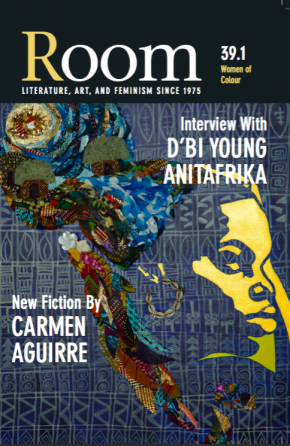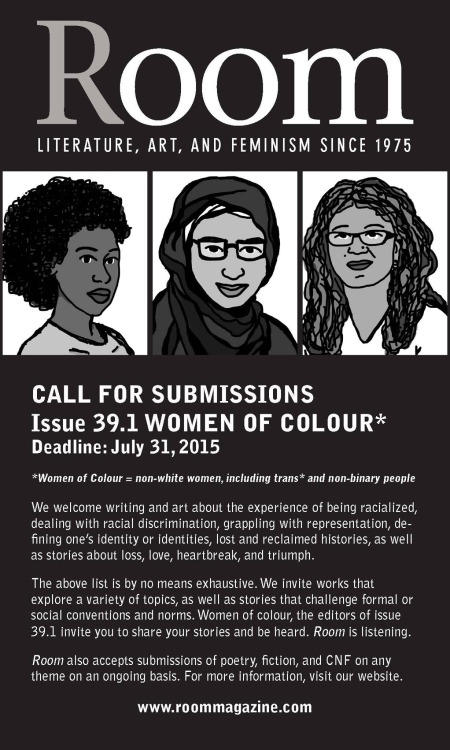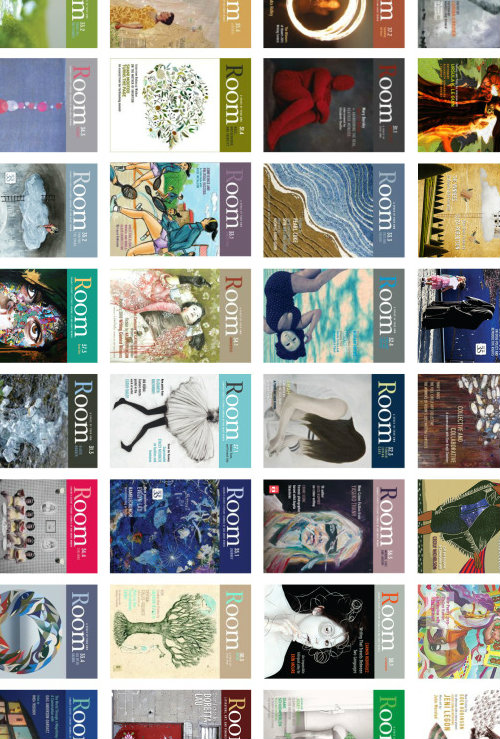As Proximity‘s editorial team takes time to reflect upon its founding mission, and how best to move into our fourth year with intention, we’ve been reaching out to editors of publications we believe are doing things right (in one way or another).
As a result, we’ve decided to share another one of those conversations with you here. In this interview, Proximity Editor Carrie Kilman talks with Room Editor Nailah King about the history of Room, the operations of an editorial collective, addressing gaps in inclusion, and the Women of Color issue that she pitched and edited.
CK: Can you tell our readers a little about Room and how the Women of Colour issue came about?
 NK: Room started in 1975, well before my time, and has a feminist mandate. Over the years there have been different iterations with the collective and we’ve featured many writers who have gone to great acclaim. With a 40-year history, it’s been interesting to work on the upcoming Room Anthology and see how the collective has changed.
NK: Room started in 1975, well before my time, and has a feminist mandate. Over the years there have been different iterations with the collective and we’ve featured many writers who have gone to great acclaim. With a 40-year history, it’s been interesting to work on the upcoming Room Anthology and see how the collective has changed.
At the time, when the Women of Colour issue was originally pitched, the makeup of the collective was less diverse. I was really pushing to have this issue because I felt like we had to call in this community that had been absent for so long from our magazine. However, the feeling for some was that there weren’t any barriers for women of colour submitting. Furthermore, they felt we should simply wait for women of colour to submit and that they’d be published eventually. To me, this wait-and-see approach wasn’t a real strategy. I have said, time and time again, writers from underrepresented communities want to see people who are like them published in a magazine before they submit themselves. So ultimately, the issue came about as a reaction to a gap in inclusion and to encourage future writers to submit to future issues.
CK: I’ve read that Room has a rotating editorship, described as a cooperative. Can you explain what this means, and how your cooperative-style editorship works? How much freedom do editors have to select themes, solicit content, make final selections, etc.?
NK: Room operates as an editorial collective and what that means is, though we have a managing editor, there is a different lead editor on every issue. There is also an assistant editor and shadow editor(s). The latter are there to learn the ropes and see the editorial process from start to finish. Editors absolutely have freedom to select themes, solicit the commission (the featured writer of the issue) and make final selections. The role of the managing editor is to provide support and work with the editor(s) to meet timelines as set out by the production schedule.
CK: In an interview with Room Managing Editor Chelene Knight, you mentioned “…if magazines want diverse content, they need to diversify their editorial boards and contest judges.” This feels like an important starting place. Can you say more about this? What is the makeup of Room‘s editorial team, and how does that influence the voices you publish and the audiences you reach?
NK: Often the awards systems in Canadian Literature (canlit for short) face the problem of having very few diverse writers as judges or jurors. Though this is changing over time, I think Room is probably most aggressive at ensuring each contest has a diverse set of judges. We recently created a diversity committee and I think diverse recruitment will be a focus of their work with the HR team.
I think for the Women of Colour issue, it helped to see two black editors at the helm of this issue. At the time, we weren’t as inclusive of women of colour as we could be, and I think being visible as editors of colour helped earn some trust back with the community of women of colour who are writers. Overall, it seems that having women of colour, queer writers and more as part of the collective makes members of those communities feel more comfortable leaving their work with us.
 Something I was reminded of at AWP is that writers of colour in particular spend a lot of time and effort making sure their work is going to the right place, and that it will end up with the right editors, who will treat their piece with the tender love and care that it deserves. As a collective, part of being inclusive is not taking that research and effort for granted, even if the piece isn’t right for Room.
Something I was reminded of at AWP is that writers of colour in particular spend a lot of time and effort making sure their work is going to the right place, and that it will end up with the right editors, who will treat their piece with the tender love and care that it deserves. As a collective, part of being inclusive is not taking that research and effort for granted, even if the piece isn’t right for Room.
CK: Our editorial team is talking about the ways in which we can more effectively create a safe and welcoming space for all writers. What are the ways in which Room is holding the door wide open for writers across race, gender, sexual orientation, and class?
NK: One way we welcome writers is that we are very explicit in our FAQ’s about inviting women writers, including trans* persons, gender-variant and two-spirit women, and women of non-binary sexual orientations to submit. We have a forthcoming queer and indigenous issues and, while special issues certainly don’t resolve the problem of inclusion automatically, I do think they open the door for underrepresented communities to see themselves within the pages. Once that happens, I think it’s more realistic to expect them to submit regularly. Still, I think each call could be explicit, and as AWP pointed out, particularly with respect to writers with a disability.
CK: In the interview with Chelene, your co-editor Christina Cooke said, “when has an issue of Room flipped the usual racial disparity and made the submission from a white author, instead of one from an Indigenous or black author, into the Token Diversity Piece?” Tokenism vs. inclusion is something I think about a lot as an editor. Can you talk about the differences between tokenism and inclusion in the literary world, from your perspective as both an editor and a writer?
NK: For me personally, tokenism manifests in many forms and one element of tokenism that I find particularly problematic is that characters are represented as stereotypes that don’t reflect the diversity even within already diverse communities. That and simply inserting one diverse character amongst a bunch of white, or straight, or able-bodied ones. That isn’t really reality or at least my reality. I think inclusion in the literary world is writing characters with purpose and depth, and avoiding stereotypes.
As an editor, I find that quite uninteresting, and as a writer, that’s not really what I write about. I’ve always been moved by different people with experiences outside of my own. It is quite cliché, but I think it’s a richer reading experience when more than one person from an underrepresented community is included and in a genuine and interesting way.
CK: What does Room look like after issue 39.1? How do you see this issue affecting theme selections and writer submissions in the future?
NK: The feedback I have received has been positive and empowering. I recently had it described as the “best issue Room has ever done” and, while I can’t lie, that’s a point of pride for me and a testament to all the hard work my editorial team did (especially Christina). I n my experience, however, many literary journals do these special issues and are done. That’s it.
Room is doing a good job at continuing to engage other misrepresented communities, but I don’t want women of colour to be forgotten. I think the future is sustainment: once you reach out and begin to create a relationship with any underrepresented community, you have to constantly insist that you want their stories, whether there’s a call specifically for them or not.
 NAILAH KING is a member of the Room editorial collective. She is also a writer, avid reader, and blogger. A UBC alumnae, she is currently working on completing a thus far untitled manuscript in prose fiction. **Editor’s Note: Nailah was a panelist in outstanding #AWP17 event titled “Creating Space for Marginalized Writers: How to Create a Diverse Programming Lineup,” with Jael Richardson, Léonicka Valcius, Kathleen Frase, and Bänoo Zan.(@PoppyPiper)
NAILAH KING is a member of the Room editorial collective. She is also a writer, avid reader, and blogger. A UBC alumnae, she is currently working on completing a thus far untitled manuscript in prose fiction. **Editor’s Note: Nailah was a panelist in outstanding #AWP17 event titled “Creating Space for Marginalized Writers: How to Create a Diverse Programming Lineup,” with Jael Richardson, Léonicka Valcius, Kathleen Frase, and Bänoo Zan.(@PoppyPiper)
This is the sixth installment in a series on race, gender, intersectionality, and literary responsibility. The first five include: “An Editorial Roundtable,” Melissa Chadburn‘s “Economic Violence”, Purvi Shah‘s “To be True in Deed to Anti-Racism Values,” Jael Richardson‘s “Creating Space for Marginalized Voices,” and “Hyphen: An Interview with Dorothy Santos.” We encourage you to share this series and join the conversation in the comments section of each post. All published posts within the series can be found here.



